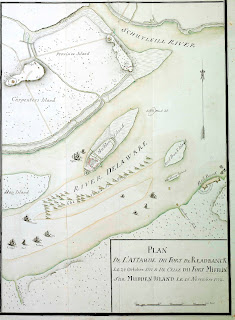 |
| Volunteers at Fort Hunter Mansion & Park |
V is for village, Vinette, Venango, value and volunteer. Volunteers and value go together when you refer to the incredible crew of volunteers in the Section of Archaeology at The State Museum. Our dedicated crew ranges in age from sixteen to sixty plus and bring a wide array of skills with them. We currently have fifteen volunteers that assist us in the lab area of the Section and an additional twenty some volunteers for our field excavations and public programs.
 |
| Charlie helping with our public archaeology program at Fort Hunter |
 |
| Clydene and Merikay, two of our expert labelers |
They help us organize the file documentation for archaeological projects, scan slides and photographs into digital formats, rehouse collections into archivally stable materials, organize the many manuscripts and reports generated with archaeological investigations and generally help in whatever task we need. These are all projects that occur in the lab, we still have the volunteers that help us with programming and field work.
 |
| Lindsey in the lab carefully labeling artifacts |
In the field our volunteers have shown us the merits of shop vac’s on cleaning up units for photographs, provided survey skills, taken photographs, skillfully drawn and recorded profiles and features. Our volunteers bring such enthusiasm to the shaker screens that we are assured that every artifact will be scoped out and recovered.
 |
| Some of our enthusiastic screeners |

Brad's smile says it all
They are careful and thorough at excavating archaeological sites and often offer a different perspective when we are attempting to identify artifacts. Their wide array of skill sets come from their diverse life experiences. We can count retired school teachers, engineering technicians, office managers, secretaries, and students in our circle of volunteers.
 |
| Charlie with a rehousing project |
 |
| Andi lending a hand in the field |
 |
| Sheila mapping our excavation at Fort Hunter in CAD |
We often encounter folks that say they always wanted to be an archaeologist, but never had the opportunity. We encourage them to come visit us at our public excavation at Fort Hunter or come into our lab and spend some time with us. This is how many of our volunteers have come to us. Many folks that thought they would like archaeology found out that they didn’t like the tedious, less glamorous tasks that come with the profession. We have been fortunate to have a core group of dedicated volunteers that have seen us through a building move, multiple personnel changes, and several computer upgrades. Our newest volunteer has just been with us a few weeks and our longest term is sixteen years. Pretty impressive! Please join us this week in recognizing and celebrating the letter V and our Valuable Volunteers.
Thanks to all of our Volunteers!
The following is a partial list of our many dedicated volunteers
Merikay Lindsey Dana Barry Jake
Andi Ande Jerry Joel Kathy
Toni Sid Kim Shellie Taylor
Clydene Melanie Parker Becky William
Stephanie Jeanne Steve Marlee Dave
Brad Harmony Addison Mary Pat Phil
Charlie Greg Aaron Les Robert
Sheila Wes Michelle Scott Elizabeth
For more information, visit PAarchaeology.state.pa.us or the Hall of Anthropology and Archaeology at The State Museum of Pennsylvania .















